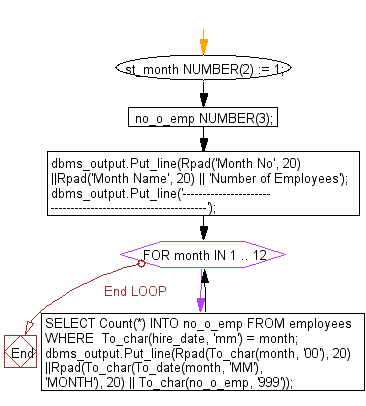PL/SQL Cursor Exercises: Display the number of employees by month. Print number of employees by month
PL/SQL Cursor: Exercise-38 with Solution
Write a PL/SQL block to display the number of employees by month. Print number of employees by month.
Sample Solution:
Table: employees
employee_id integer first_name varchar(25) last_name varchar(25) email archar(25) phone_number varchar(15) hire_date date job_id varchar(25) salary integer commission_pct decimal(5,2) manager_id integer department_id integer
PL/SQL Code:
DECLARE
st_month NUMBER(2) := 1;
no_o_emp NUMBER(3);
BEGIN
dbms_output.Put_line(Rpad('Month No', 20)
||Rpad('Month Name', 20)
|| 'Number of Employees');
dbms_output.Put_line('-------------------------------------------------------------');
FOR month IN 1 .. 12 LOOP
SELECT Count(*)
INTO no_o_emp
FROM employees
WHERE To_char(hire_date, 'mm') = month;
dbms_output.Put_line(Rpad(To_char(month, '00'), 20)
||Rpad(To_char(To_date(month, 'MM'), 'MONTH'), 20)
|| To_char(no_o_emp, '999'));
END LOOP;
END;
/
Sample Output:
SQL> / Month No Month Name Number of Employees ----------------------------------------------------------- 01 JANUARY 14 02 FEBRUARY 13 03 MARCH 17 04 APRIL 7 05 MAY 6 06 JUNE 11 07 JULY 7 08 AUGUST 9 09 SEPTEMBER 5 10 OCTOBER 6 11 NOVEMBER 5 12 DECEMBER 7 PL/SQL procedure successfully completed.
Flowchart:

Go to:
PREV : Write a PL/SQL block to display the last name, first name and overpaid amount by using parameters.
NEXT : Write a PL/SQL block to display the last name of manager, and their departments for a particular city, using parameters with a default value in explicit cursor.
Improve this sample solution and post your code through Disqus
What is the difficulty level of this exercise?
